
The British Virgin Islands (BVI) is, probably, the best place to rent a yacht if you are, well, a bareboat chartering virgin. This was the destination of my first bareboat charter. We sailed a catamaran here with two other couples for seven memorable days several years ago. Even if you already have extensive experience boating elsewhere, you’ll have an incredible time on a rental yacht in the BVI.
What’s Hot
- Lots of boats and charter companies to choose from
- Easy sailing
- You are never more than an hour away from food, water, and fuel
- Clear, warm water
What’s Not
- Hard to get to from the Continental US
- Can be crowded, depending on season
There’s no shortage of things to do while on your bareboat yacht charter in the BVI. If you need help planning your itinerary, check our list of 10 Things to do & 4 not to in the British Virgin Islands.
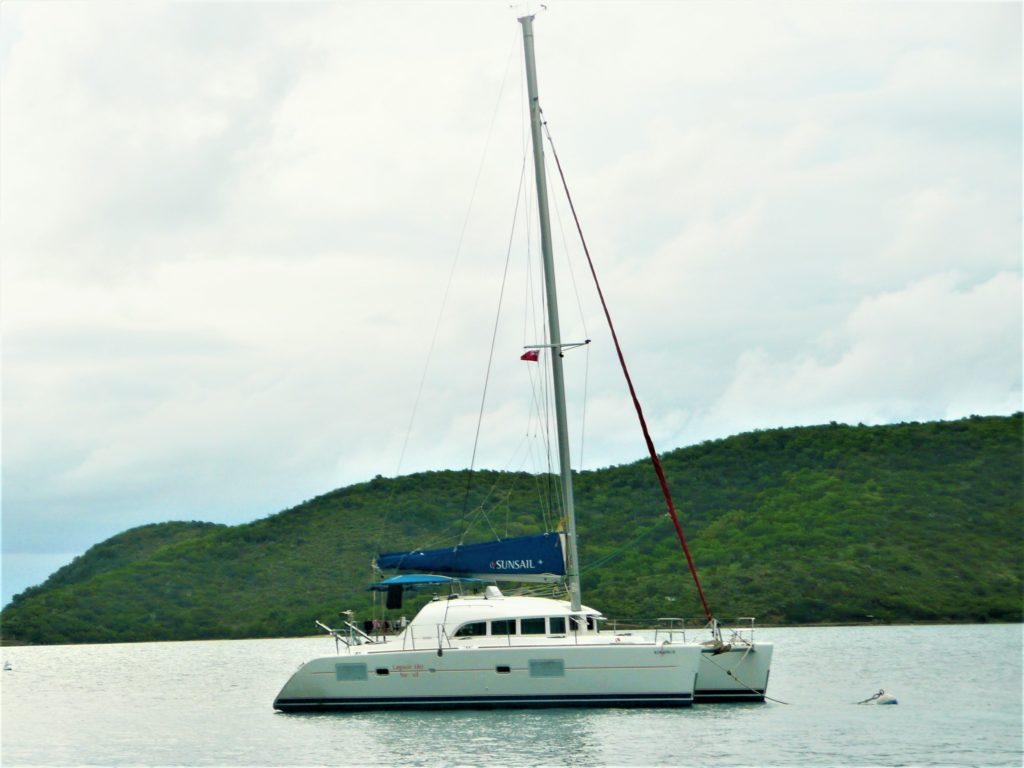
Yacht Rental Options in the BVI
‘Bareboat’ yacht chartering was invented here. The BVI has more yachts available for bareboat than anywhere else in the world. A ‘bareboat’ is a yacht rental that comes without a captain or provisions (food). Usually referring to boat large enough to cruise on for a week or more. You, as the renter, do the sailing, the cooking, and set the itinerary. The most common path here is to rent a 30′-50′ sailboat for a weeklong tour of the islands. Sailing catamarans are very common here, but traditional monohulls are also available. Motor yachts are available as well; primarily power catamarans.
Catamarans are less common in mainland US because they are much wider than traditional monohull boats. This makes dock space expensive and difficult to find. However, here in the Caribbean, where you often don’t use a dock (read on), catamarans offer significantly more space in a given length of boat. Most have four or more staterooms, so you can bring more friends to share the costs and enjoy the fun. You’ll also have a lot more deck space to spread out and enjoy the weather on a catamaran.
If you aren’t coming to the British Virgin Islands specifically to cruise on a yacht, there are options to rent boats for the day as well. Sportfishing boats, jet skis, and Hobie Cats are available for rent on the islands of Virgin Gorda and Tortola. However, this article will focus on bareboat yacht chartering.
Sailing (or Boating) in the BVI
There are a number of features that come together to make this one of the best destinations in the world for sailing, especially for beginners considering a yacht rental.
Consistent Wind
Most of the year, wind blows through the islands at 10-20 knots from a consistent direction throughout the day. Outside of the low season, there’s little reason to worry about standing still in calm weather.
Line of Site Navigation
The BVI is an archipelago with a number of smaller islands surrounding the largest island of Tortola in the center. Unless you sail to Anageda, you’ll never be out of site of land. In fact, a Placemat or souvenir map of the BVI might be the most useful navigating tool here. If you know what harbor you are in, find it on the placement, along with the next habor you’d like to head to. Then look up, turn your head in that direction, and sail that way. Even without any charts, you’ll always have a good idea how to get back to Road Town in Tortola; where your charter base will likely be located.
This navigation from harbor to harbor is what the BVI is all about. Each island has several harbors suitable to anchor. Each day you might spend an hour moving your boat from one to the next. Then, take your dinghy to shore to explore, jump off the boat to snorkel, or just relax on the boat. Everything is so close together that if you don’t find what you are looking for in one anchorage, you’ll likely still have plenty of daylight to cruise to one or two more.
The Islands are Exhaustively Documented
The Cruising Guide to the Virgin Islands by Simon Scott seems to be the top guide for the BVI. Your charter company will likely include a copy on the yacht you rent, but I ordered one ahead of our trip to help with planning. This is the best cruising guide I have seen for any cruising grounds. The aerial photographs and descriptions of where to anchor and how to approach each anchorage really make approaching shallower water less stressful. It has very good documentation to help prepare for your trip including weather expectations, how to pack, and exhaustive documentation about what you’ll find on each island. It also includes a folded 18″‘x24″ waterproof chart that could completely meet all of your navigational needs. You could even consider this your ‘placemat’, but a laminated placemat is still a bit more handy and less likely to blow around on deck.
Aside from Scott’s Guide, charts are widely available, and most charter companies also offer a lot of advice about the area online. The US Government source for nautical charts, NOAA, publishes charts for the US and British Virgin Islands, but you will likely need to purchase a separate chart package for this area if you have a chartplotter or cell phone navigation app, such as Navionics, that you use in the Continental US.
You Don’t Need to be an Ace at Docking…or Anchoring
Many boaters, including myself, fear docking even more than public speaking or snakes. In the BVI, you’ll probably only ever touch a dock on the first and last day of your yacht rental. Most charter companies will have your boat moored in a slip in a marina. So, you will have to pull it out, turn it, and navigate the docks out of the harbor; and do the opposite upon return. Luckily the charter companies have plenty of hands on the dock to help push you off and bring you in. Don’t be embarrassed to ask for help by shouting to someone on the dock, or calling the marina or charter company on the phone. You want your deposit back, and the charter company really does want to give it back, so they’ll be happy to help.
Once you’ve left the marina, you’ll head to any number of anchorages where you’ll leave your boat and head to shore in your dingy. Most of these anchorages have fields of mooring balls, so you won’t even need to anchor. If you’ve never used a mooring ball, it’s a cinch. The peace of mind that comes from a secure mooring ball will help you sleep far better than an anchor will. We drug a mooring ball one night in some nasty winds on the North end of Virgin Gorda, which was very unsettling. But even then, we didn’t lose holding and float out to see. If you do anchor, the cruising guide will help you find a safe place to anchor with good holding. The clear, warm water means it’s easy to hop in the water with goggles and a snorkel to check your work.
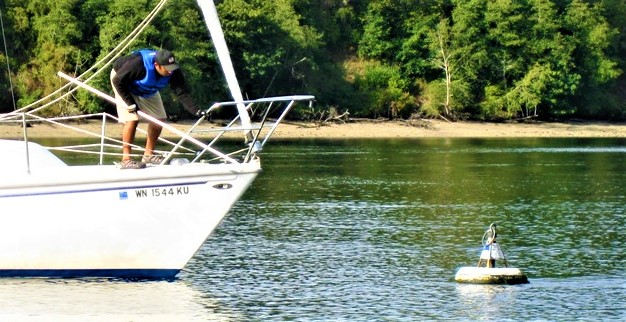
The Chart Briefing is Short
Most charter companies, anywhere, will host a chart briefing to discuss navigational hazards and other considerations specific to the local cruising grounds before sending you out on your rental yacht. The key takeaways from the briefing: 1) do not go to Necker Island, it is a private island (they told us this, like, ten times, so it must be an issue) and 2) don’t anchor in coral. There are just not a lot of navigational hazards, like hidden rocks or pilings here. You also won’t be impacted much by tides or currents, which could otherwise necessitate more planning in terms of travel times and how you set an anchor. Just plot a course through the deep water on the chart and go. I also recommend you reference a cruising guide to safely approach anchorages.
Help is Never Far Away
You’ll never be more than an hour (usually far less) away from food, water, or fuel, and not more than three hours from your charter base.
There’s no need to oversupply the boat before heading out; just order enough food and water for a few days, and pick up more along the way. We pre-ordered our food and had it delivered to our boat by Bobby’s Marketplace. This was a convenient way to start the trip, especially for heavy items like water. However, in the hot, humid, Caribbean Sea, anything perishable that isn’t refrigerated will decay by the hour, so it’s nice to be able to buy fresh items ‘less, more often’ here. If someone on your boat uses all the water in the shower on the first day, you can easily find a place to refill the tanks. If something goes wrong with the boat, it can be fixed quickly.
When our dinghy davit failed, dropping the dinghy in the water, one of the lines fouled (got wrapped around) the prop on our starboard (right) engine. We just shut the engines down, put the sails up and tacked back to Road Town as we got on the phone with the charter company. They were waiting for us at the dock to tow us the final few feet since we wouldn’t be able to turn the boat into the slip on one engine. A diver came down and cut the line while someone else fixed the davit. We were back on our way in less than 30 minutes with a few more memories to take home.
When to Go
Based on the charter price lists, I’d divide the BVI yacht rental seasons into the following:
- High Season: February to April. Covers Spring Break holidays in the US and Half Term holidays in Europe. This time of year offers consistent winds and drier weather ideal for sailing.
- Christmas: This is a second peak: travelers are on holiday, and the winds are exceptionally strong.
- Shoulder: May to June and November
- Low: July to October. This is hurricane season.
Low Season Rocks!
We rented our catamaran in the BVI in September, during the low season, primarily to save money and avoid crowds. September will tend to be lower (in price and crowds) than August because school calendars compound the low demand; but then if you must travel when school is out, August is still a viable option. However, the low season here brings some other unique pluses and minuses…
Price
This may be the most obvious reason to travel off-season. Before having a child, I traveled off season almost exclusively to save money on airfare. You can also find very significant discounts on yacht rentals. The smaller boats, which tend to book first, are also more likely to be available at this time.
No Crowds
For all the stories we heard about crowds in the British Virgin Islands, we shared an anchorage each night with one or two other boats, and dozens of empty mooring balls. One exception was when a cruise ship moored on Tortola. After a peaceful evening watching the sunset from the only restaurant open in Cane Garden Bay, we woke up to what looked like the beach party in Apocalypse Now. Every store in town was open and bustling. Tourists were all over the beach with locals cruising through to peddle wheelbarrows of coconuts and shower rods hanging dozens of t-shirts.
If your comfort level on your charter boat is limited, you’ll enjoy the extra room to maneuver and lack of traffic to navigate.
The Weather
In the BVI, the low season antithetically occurs during August and September: partially during school holidays, but also during the two warmest months. When we were there, in September, the water was so warm that we never used the showers in the boat. We just jumped off the stern (back) with a bar of soap, and rinsed the salt off with the deck shower.
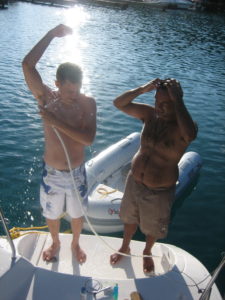
Beware: Low Season is Still Low for a Reason
While we were happy with the offseason, I’d be remiss if I didn’t share the disadvantages as well:
The Weather
An explanation of this oddly timed low season lies in the fact that the warm waters mentioned above bring hurricanes, squalls (little fast moving rain storms), and less consistent winds
There was an active hurricane in the Caribbean while we were on our boat. While it didn’t affect us directly, we were able to see it on our flight in, and it was responsible for redirecting the aforementioned cruise ship in our direction. Sunsail recommended we invest some of our savings into trip insurance given the risk that the trip could be disrupted by weather. We obliged in this case.
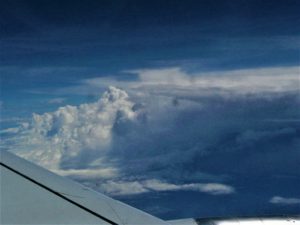
During the day, the weather was mostly clear and dry. Occasional squalls would move through quickly, and were actually visible from enough distance that you could often out maneuver them. Nights were another story: we’d open hatches in the cabins to cool off while sleeping, but then be awoken by rain coming through, rush to close the hatch, then wake up an hour later to open the hatch to make the hot, wet air less miserable. This tireless cycle seemed to repeat almost hourly each night. A strong argument for chartering a boat with air conditioning.
There wasn’t much wind for sailing, and when there was, it was inconsistent. As a result, we motored much more than we sailed. We got where we needed to go just fine, but if sailing is an important part of your trip, the low season may not be ideal.
Limited Activities
Each harbor we visited had exactly one restaurant open. Having been raised in the USA, it felt odd not to have any choice, but we had an enjoyable meal everywhere we went, regardless. The situation also allowed us to find our friends that went ashore as we all landed at the same restaurant one night.
Spending the week on a 16,000 pound catamaran, I longed to sail one of the dinghies from a rental company in Virgin Gorda, but, alas, the rental company was closed for the season.
Getting to your BVI Yacht Rental
Getting to your bareboat yacht charter the BVI is not quite as easy as getting to Space Mountain in Disney World since it is an island.
Until recently there were no direct flights from the Continental US despite the fully modern international airport on Tortola. Coming from the US, you’d either fly into San Juan, Puerto Rico, then switch to a small prop plane to the Islands, or fly into St Thomas, US Virgin Islands, and complete your journey by boat.
2023 UPDATE: American Airlines is starting regional service to Tortola from Miami this Summer! This will allow American’s to make the trek on a jet on a single ticket for less money and (depending on departure city) in less time. As of Spring 2023 there plenty of seats available from Portland, OR (and other cities) for under $700 round trip. Without direct service to Miami, we still have two layovers and 16-20 hours of travel from Portland. Regardless, this is still an improvement.
All bareboat yacht charters in the BVI depart from Tortola, mostly in Road Town. Look for flights to airport code EIS, which is technically on Beef Island, but there is a road from there to Tortola. When taking a ferry, you’ll most likely want to land in Road Town, but a few charters start in Soper’s Hole, and ferries service that port as well.
If the American Airlines itinerary doesn’t work for you, or you want to make getting there more of an adventure, here’s more info on prop planes and ferry service…
Fly in From Puerto Rico
We chose the San Juan route because we couldn’t get a reasonable flight into St Thomas. However, we discovered that this route may include additional worthwhile adventures.
The little plane was fun, the view was amazing, the pilot was a comedian, and he may or may not do a barrel roll if everyone on board can keep a secret. But wait there’s more: you’d think a short flight from San Juan to Tortola would be direct, but you’d be wrong. If anyone buys a ticket for Virgin Gorda that day, you will have a layover. This is one layover you don’t want to miss: while Tortola has a fully modern airport, Virgin Gorda has a short, dirt runway on the edge of the ocean that you’ll get to land and take off from while enjoying the view from right behind the pilot. You’ll also have no line to clear customs in Virgin Gorda.
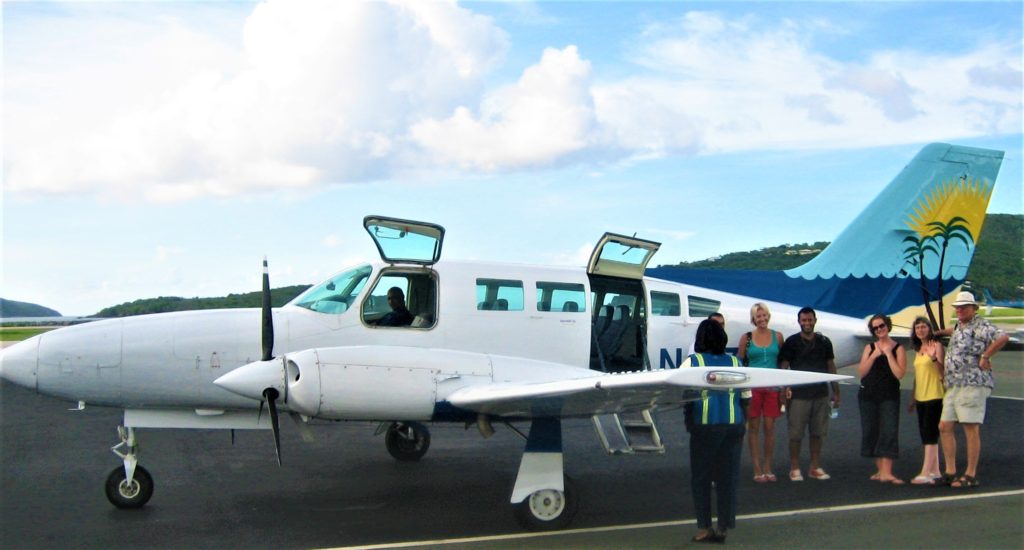
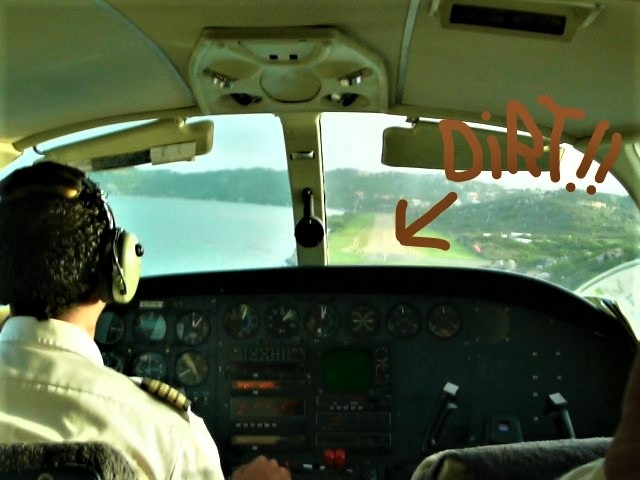
We had a pretty boring six-hour layover in the San Juan airport on the way to the BVI, but on our return trip, we had an overnight layover that allowed is to enjoy the City. The architecture, coffee, and Cubanos were all a real treat.
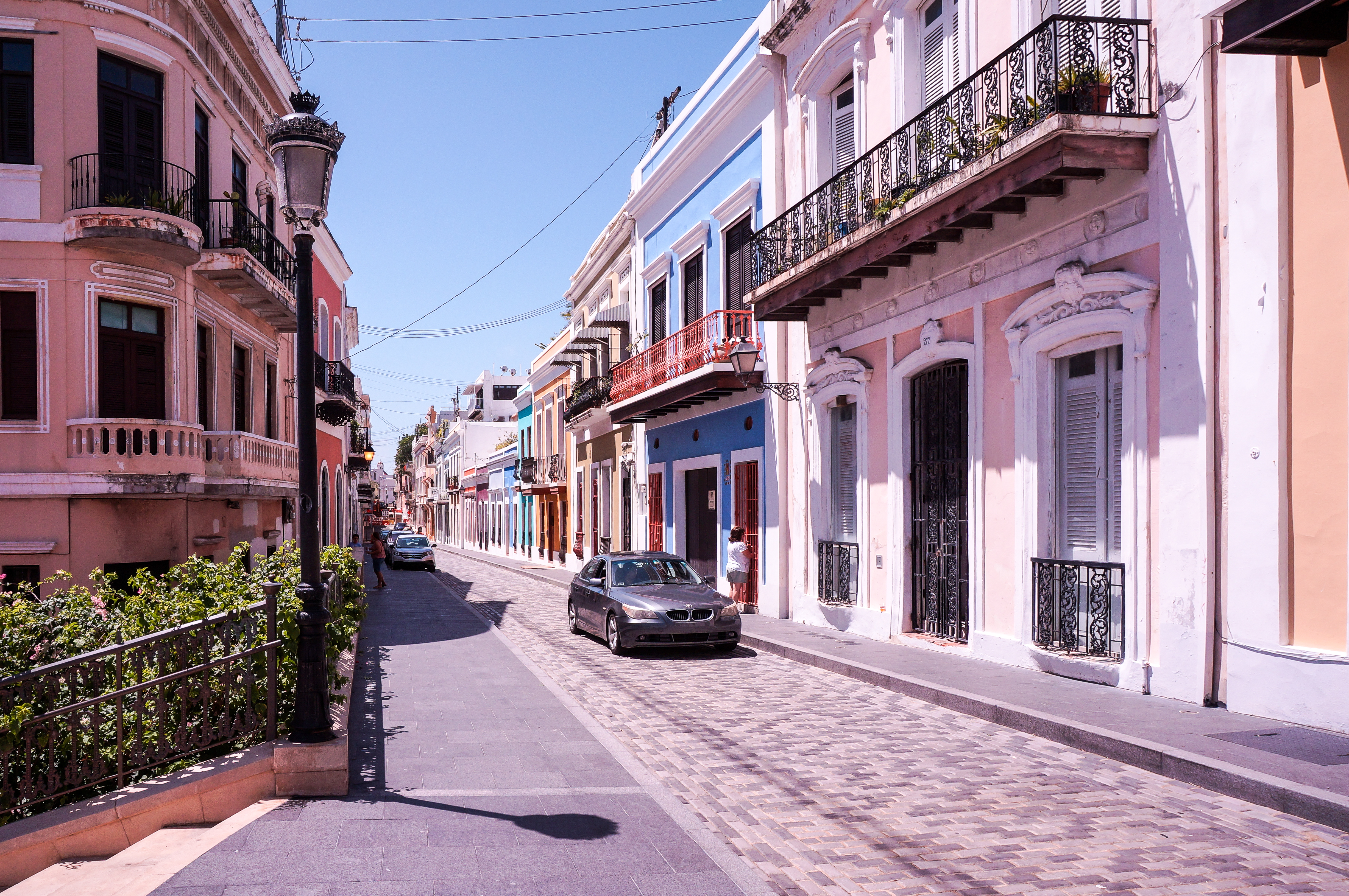
Take a Boat from St Thomas
If you are traveling from the East Coast, the St Thomas route will most likely be less expensive than Puerto Rico: flights from Puerto Rico to Tortola can run $350, but a roundtrip on the ferry from St Thomas is around $80. Actually, from St Thomas you have two potentially effective options:
Option 1: take a ferry to your charter in Tortola.
Option 2: start your charter in St Thomas. More and more charter companies are setting up shop in St Thomas, making this a viable option. Just keep in mind that the journey from St Thomas is 10-15 miles depending on your charter base, and you’ll need to clear customs on your boat in both directions. Clearing customs on your own boat can be more intimidating than other border crossings because, as the skipper, it is your responsibility to navigate across the border properly, proceed to a port of entry (a dock with customs office), and lead your crew through customs. If you came to the Caribbean for the sailing more than the cruising, the trip from St Thomas on your charter boat might just be part of the adventure you came for.
How Long Should You Plan to Spend in the BVI?
You can reasonably plan a fulfilling trip with 7 days of travel. We had 9 total travel days, necessitating only one week off of work:
- Fly out on the Friday night redeye
- Sleep on the boat at the dock Saturday night after provisioning
- Chart briefing and head out Sunday morning
- Return to the dock and sleep on the boat Friday night (seven-day charter)
- Fly to San Juan Saturday morning
- One night in San Juan
- Fly home Sunday
The itinerary above, worked perfectly into a two weekend plus one work week vacation. If you needed to do reduce that, you might be able to take some days off of travel, especially if coming from the East Coast. In the BVI, the distances are close and there’s little weather delays, so you could also do and see a lot with a five-day charter. In fact, if I were to do it all over again, I’d take one day off the charter and spend another day in Puerto Rico.
If you have the time and money, you could certainly make this into a longer trip. More time would allow you to sail to the US Virgin Islands or Anageda, for example.
What Skills and Experience do You Need to Take This Trip?
As I mentioned above, this is an easy place to cruise. However, everything is relative. Despite the lack of obvious challenges related to this particular cruising ground, we were unsupervised and responsible for a $200,000 yacht, as well as our own lives, in the ocean, in a foreign country. We did run into a few problems, some of which we created, some of which the world brought to our feet, but all had to be solved by our crew. Our crew of six included two people with some prior experience sailing bareboat charters with friends in the Pacific Northwest, one with formal training. Two more of us had just recently taken sailing classes that Summer, one of them had some prior cruising experience on motor yachts.
I’m sure a less experienced crew would be allowed to rent a yacht here in the BVI. However, there were times that I felt like we were at the limits of our abilities. Based on my experience, I think that a charter company will be willing to put you on a boat before you are comfortable taking the boat. If you don’t know if you are comfortable, you probably need some experience out on the water on a boat with a friend that can let you take control, or with formal classes. We’ll discuss those options soon.
The Bottom Line (Cost)
Below is what it would cost to share a similar trip to ours with six people, renting from Sunsail in Road Town, BVI for 7 days, and flying from Portland, OR the week after Labor Day, 2022. Cost of the rental yacht and airfare starts at $1,400 per person for a monohull, and $2,000 per person for a catamaran.

When we rented our Lagoon 380 from Sunsail, the total trip cost was just under $8,000 for six of us. At that time, off-season discounts were more aggressive and Sunsail has since stopped renting catamarans without air conditioning, which rented for quite a bit less than the larger, better equipped catamarans currently on offer.
Reduce the Cost of Your Yacht Rental
- Save:
- $300 per person on the catamaran with two additional people on board.
- $250 per person by flying into St Thomas and taking a ferry.
- $80 per person on ferries by chartering from St Thomas.
- Shop around with other charter companies that may have older, smaller boats, such as Conch Charters:
- 38 foot catamarans (without air conditioning) for as low as $4,700 for 10 days.
- 32-foot monohulls for as low as $2,300 for 10 days.

Necker Island Man. Do the right thing.